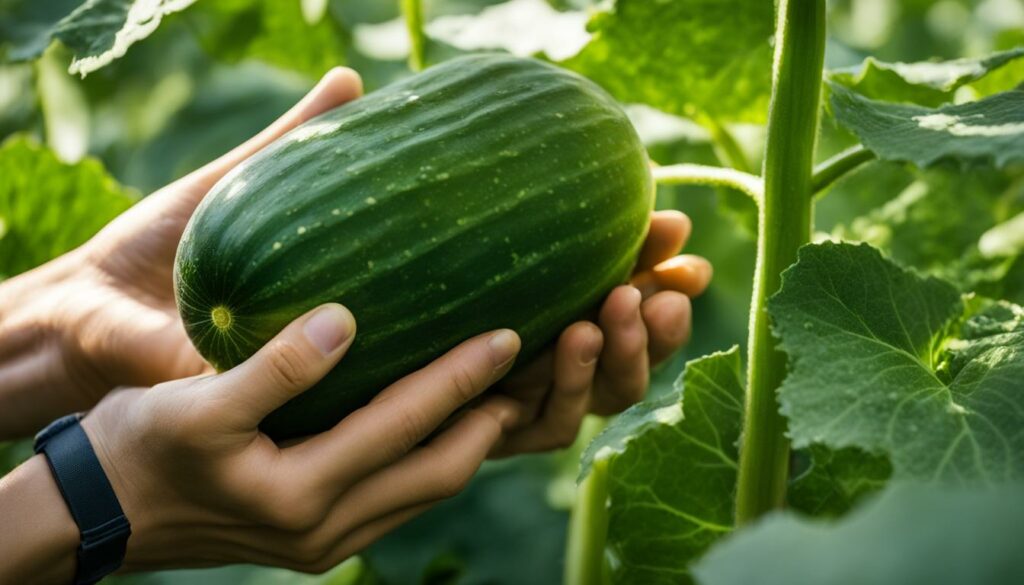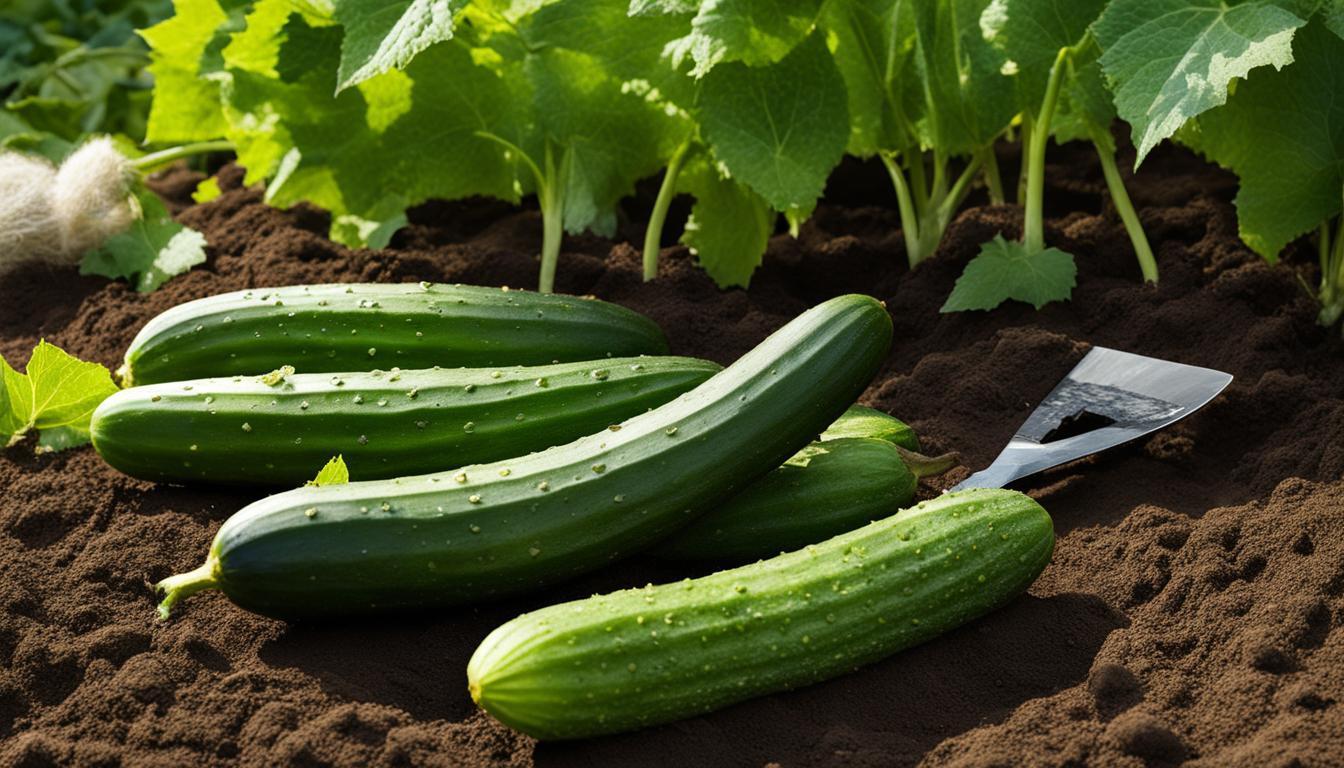Are you interested in cucumber gardening? Looking to cultivate cucumbers and enjoy the satisfaction of growing your own fresh produce at home? You’ve come to the right place! In this article, we will provide you with essential cucumber plant care tips and a step-by-step guide on how to grow cucumbers from scratch.
Whether you’re a seasoned gardener or a complete beginner, growing cucumbers is a fantastic choice. Not only are they easy to grow, but they also offer a variety of uses. You can enjoy them fresh in salads, sandwiches, or smoothies, or preserve them by making pickles and relish.
Cucumbers are not only delicious but also packed with phytonutrients and various health benefits. They are a rich source of Vitamin K and contain flavonoids, lignans, and triterpenes, which have antioxidant, anti-inflammatory, and potential anti-cancer properties.
So, let’s dive into the world of cucumber gardening and discover the secrets to growing cucumbers at home. From choosing the right variety to planting and taking care of your cucumber plants, we’ve got you covered!
Nutritional Value of Cucumbers
Cucumbers are not just water-filled, they also contain essential nutrients such as Vitamin K. Additionally, cucumbers are rich in phytonutrients, including flavonoids, lignans, and triterpenes, which have antioxidant, anti-inflammatory, and potential anti-cancer properties. These nutrients contribute to the health benefits of cucumbers and make them a nutritious addition to your diet.
Let’s take a closer look at the nutritional content of cucumbers:
- Cucumbers are low in calories, making them a great option for weight management.
- They are a good source of Vitamin K, which is essential for blood clotting and bone health.
- Cucumbers contain Vitamin C, an antioxidant that supports immune function and collagen production.
- They are a good source of dietary fiber, which aids in digestion and promotes feelings of fullness.
- Cucumbers are also rich in water, contributing to hydration and promoting healthy skin.
Phytonutrients in Cucumbers
In addition to their nutritional value, cucumbers contain a variety of phytonutrients that provide health benefits. Flavonoids, such as quercetin and apigenin, have been found to have anti-inflammatory and antioxidant properties. Lignans, such as lariciresinol and pinoresinol, may have potential anti-cancer effects. Triterpenes, including cucurbitacins, have been shown to exhibit anti-inflammatory and anti-cancer properties in preclinical studies.
These phytonutrients not only contribute to the nutritional value of cucumbers but also play a role in their potential health benefits. Including cucumbers in your diet can provide a refreshing and nutritious addition to your meals while supporting overall well-being.
Cucumbers are more than just a crunchy and hydrating vegetable. They are packed with essential nutrients like Vitamin K and contain phytonutrients with potential antioxidant, anti-inflammatory, and anti-cancer properties. Including cucumbers in your diet can provide numerous health benefits and contribute to your overall well-being.
Different Varieties of Cucumbers
When it comes to cucumbers, there are various exciting varieties to choose from. Whether you prefer pickling cucumbers for your homemade relish or slicing cucumbers for fresh salads, there’s a cucumber type that suits your needs. Let’s explore some popular cucumber varieties:
1. Pickling Cucumbers
Pickling cucumbers, also known as gherkins, are small-sized cucumbers that are perfect for canning and preserving. They have a firm texture and slightly acidic taste, making them ideal for pickling. Some popular pickling cucumber varieties include National Pickling and Boston Pickling.
2. Slicing Cucumbers
Slicing cucumbers are larger in size and are commonly used for fresh consumption. These cucumbers have a crisp texture and mild flavor, making them perfect for salads and sandwiches. Popular slicing cucumber varieties include Marketmore and Straight Eight.
3. Greenhouse Cucumbers
Greenhouse cucumbers are grown in controlled environments, such as greenhouses or hydroponic systems. These cucumbers tend to have a smoother skin and are seedless or have small, soft seeds. English cucumbers, also known as European cucumbers, are a popular type of greenhouse cucumber. They are longer and narrower compared to traditional cucumbers, with a mild and refreshing taste.
4. Outdoor Cucumbers
Outdoor cucumbers, as the name suggests, are grown in outdoor gardens. They are typically more tolerant of various weather conditions and have a more robust flavor compared to greenhouse cucumbers. Outdoor cucumber varieties include Diva and Lemon cucumbers. Lemon cucumbers, in particular, are small and round with a bright yellow color, resembling a lemon.
By exploring these different cucumber varieties, you can select the ones that best suit your taste preferences and gardening conditions. Experiment with different cucumber types to enjoy a diverse range of flavors and textures in your culinary creations.
| Cucumber Variety | Best Use | Size/Shape | Flavor |
|---|---|---|---|
| Pickling Cucumbers | Pickling and preserving | Small-sized, cylindrical | Slightly acidic |
| Slicing Cucumbers | Fresh consumption, salads, sandwiches | Medium to large-sized, elongated | Mild and crisp |
| Greenhouse Cucumbers | Controlled environment growing | Long and narrow | Mild and refreshing |
| Outdoor Cucumbers | Outdoor gardens | Varies (e.g., round, elongated) | Robust |
Remember to choose cucumber varieties that thrive in your climate and growing conditions for the best results. Now that you know about the different cucumber types available, you can select the ones that cater to your culinary preferences and gardening aspirations.
Planting Cucumbers
Planting cucumbers is a straightforward process that requires attention to a few key factors. The success of your cucumber plants depends on providing the right soil conditions, sun exposure, and watering regimen. Let’s explore each of these aspects in detail:
Soil Requirements
Cucumbers thrive in well-draining soil with a pH level of 5.5 to 7. The soil should be rich in organic matter to retain moisture without becoming waterlogged. Sandy soils are ideal for cucumbers, but if you have clay soil, you can improve its quality by adding compost and aged manure. This helps with drainage and provides essential nutrients for healthy plant growth.
Sun Exposure
Cucumbers are sun-loving plants and require full sun exposure to flourish. Ensure that your planting area receives at least 6-8 hours of direct sunlight each day. Adequate sunlight promotes vigorous growth and helps in the development of high-quality cucumbers.
Watering Cucumbers
Cucumbers have high water requirements, particularly during periods of hot weather. It is crucial to water them consistently to keep the soil evenly moist. Aim for about one inch of water per week, either through rainfall or irrigation. Avoid overwatering, as it can lead to root rot and other fungal diseases. Remember to water at the base of the plants, keeping the leaves dry to prevent leaf diseases.
| Soil Requirements | Sun Exposure | Watering |
|---|---|---|
| Well-draining soil with pH 5.5-7 | Full sun exposure (6-8 hours) | Consistent watering to keep soil moist |
| Rich in organic matter | Promotes vigorous growth | Avoid overwatering; water at the base |
| Sandy soil is ideal; add compost to clay soil | Enhances cucumber quality | One inch of water per week |
By following these guidelines for planting cucumbers, you can provide your plants with optimal conditions for healthy growth. In the next section, we will discuss the care and maintenance required to ensure a successful cucumber harvest.
Care for Cucumber Plants
Proper care is essential for the healthy growth of cucumber plants. Here are some tips to help you take care of your cucumber plants:
Watering Tips
Cucumbers are thirsty plants and require regular watering. Aim to provide about an inch of water per week, evenly distributing it at the base of the plants. Avoid overhead watering as wet leaves can lead to leaf diseases. Mulching around the plants can help retain moisture and reduce evaporation, ensuring the soil stays consistently moist.
Trellising Cucumbers
Training cucumber plants to grow on trellises or stakes has several benefits. It helps keep the fruit off the ground, preventing rot and damage. Trellising also promotes better air circulation around the plants, reducing the risk of diseases. As the vines grow, gently guide them along the trellis or secure them with soft ties. This method also saves space in the garden and makes harvesting easier.
Mulching Cucumbers
Mulching is beneficial for cucumber plants in multiple ways. A layer of organic mulch, such as straw or shredded leaves, helps suppress weed growth, conserves soil moisture, and maintains a more stable soil temperature. Apply a thick layer of mulch around the base of the plants, taking care not to cover the stems directly. This also prevents soil splashing onto the leaves, reducing the risk of diseases.
| Task | Timing |
|---|---|
| Fertilizing | Once a month during the growing season |
| Pruning | As needed to remove damaged or diseased leaves |
| Pollination | Hand pollination may be required in greenhouses |
By following these caring tips, you can ensure healthy cucumber plants and a bountiful harvest of delicious cucumbers. Remember to monitor your plants regularly, address any issues promptly, and provide them with the ideal growing conditions.

Common Pests and Diseases
While cucumbers are relatively easy to grow, they can be susceptible to certain pests and diseases that can hinder their growth and productivity. Understanding and identifying these common issues can help you take appropriate preventive measures and maintain a healthy cucumber garden.
Pests:
Cucumber Beetle:
The cucumber beetle is a common pest that can cause significant damage to cucumber plants. These beetles feed on the leaves, stems, and fruits of the plants, resulting in stunted growth and reduced yields. To control cucumber beetles, you can use insect netting to prevent them from accessing the plants or employ organic insecticides that specifically target these pests.
Diseases:
Powdery Mildew:
Powdery mildew is a fungal disease that affects cucumber plants, resulting in a powdery white coating on the leaves. This disease thrives in warm and humid conditions and can cause foliage to yellow and wilt. To prevent powdery mildew, ensure proper air circulation by spacing plants adequately and avoid overhead watering. Fungicidal sprays can be used to control the spread of the disease.
| Pest/Disease | Symptoms | Prevention |
|---|---|---|
| Cucumber Beetle | Feeding damage, stunted growth, reduced yields | Insect netting, organic insecticides |
| Powdery Mildew | Powdery white coating on leaves, yellowing, wilting | Adequate spacing, avoid overhead watering, fungicidal sprays |
It is crucial to regularly monitor your cucumber plants for any signs of pest infestation or disease development. Early detection and appropriate action can help prevent severe damage and ensure a successful cucumber harvest.
Harvesting Cucumbers
Harvesting cucumbers at the right time is crucial to ensure optimal flavor and texture. So, when is the best time to pick your cucumbers? It depends on the variety and intended use. Generally, cucumbers are ready for harvest when they reach their mature size and have a firm texture. For slicing cucumbers, this is usually when they are about 6 to 8 inches long. Pickling cucumbers, on the other hand, are harvested when they are smaller, around 2 to 4 inches in length.
To determine if a cucumber is ripe, look for a deep green color and a smooth skin. Avoid cucumbers that have turned yellow or have a wrinkled appearance as they can be overripe and may not taste as good. It’s also important to note that cucumbers left on the vine for too long can hinder the plant’s productivity, so it’s best to remove any overripe cucumbers promptly.
When harvesting cucumbers, use a sharp knife or pair of scissors to cut the fruit from the vine, being careful not to damage the plant. It’s advisable to harvest cucumbers in the morning when the temperatures are cooler, as this can help preserve their freshness. Once harvested, cucumbers can be stored in the refrigerator for up to a week. Remember to wash them thoroughly before consuming or using them in your favorite recipes!

A Quick Guide to Harvesting Cucumbers:
- For slicing cucumbers, harvest when they are 6 to 8 inches long and have a firm texture.
- For pickling cucumbers, harvest when they are 2 to 4 inches in length.
- Look for deep green color and smooth skin when determining ripeness.
- Avoid cucumbers that have turned yellow or have a wrinkled appearance.
- Use a sharp knife or scissors to cut the fruit from the vine.
- Harvest cucumbers in the morning when temperatures are cooler.
- Store harvested cucumbers in the refrigerator for up to a week.
- Wash cucumbers thoroughly before consuming or using in recipes.
By following these simple guidelines, you can enjoy the fresh and delicious taste of homegrown cucumbers in your salads, sandwiches, and other culinary creations!
| Variety | Mature Size | Best Use |
|---|---|---|
| Marketmore76 | 6 to 8 inches | Slicing |
| Boston Pickling | 2 to 4 inches | Pickling |
Best Cucumber Varieties for Beginners
When it comes to growing cucumbers as a beginner, choosing the right variety can make all the difference. Some cucumber varieties are more beginner-friendly, with traits that make them easier to grow and care for. Here are some recommended cucumber varieties that are perfect for beginners:
Marketmore76
The Marketmore76 cucumber is an excellent slicing variety that is known for its exceptional taste. It produces long, dark green cucumbers that are crispy and refreshing. This variety is disease-resistant and has good tolerance to common cucumber pests, making it a reliable choice for beginners.
Boston Pickling
For those interested in pickling cucumbers, the Boston Pickling variety is a popular choice. This variety is specifically bred for making pickles and has a crisp texture and excellent flavor. It is a high-yielding variety that is easy to grow and provides consistent results.
Picklebush
If you have limited space or want to grow cucumbers in containers, the Picklebush variety is a great option. This compact cucumber plant is ideal for small gardens or patio containers. It produces short, flavorful cucumbers that are perfect for pickling or fresh consumption.
When selecting cucumber varieties for your garden, it’s always a good idea to check with local garden centers or nurseries for varieties that are well-suited to your specific region and climate. By choosing the right cucumber variety, you can set yourself up for a successful and satisfying cucumber-growing experience as a beginner.
Conclusion
In conclusion, growing cucumbers can be a fun and rewarding endeavor, especially for beginners. By following the step-by-step guide provided in this article, you can successfully cultivate your own fresh cucumbers at home. Remember to choose the right variety based on your preferences and growing conditions, whether it’s pickling cucumbers, slicing cucumbers, or container-friendly varieties.
Providing the optimal growing conditions, such as well-draining soil, full sun exposure, and regular watering, is crucial for the healthy development of cucumber plants. Additionally, implementing trellises and mulching techniques can enhance plant growth and prevent common issues like fruit rot and weed growth.
It is important to be aware of potential pests and diseases that can affect cucumber plants, such as cucumber beetles and powdery mildew. Regular monitoring and taking prompt action can help minimize these problems and ensure the success of your cucumber crop.
Lastly, harvesting cucumbers at the right time and handling them with care will ensure the best flavor and quality. Whether you enjoy them fresh or choose to preserve them as pickles and relish, the taste of homegrown cucumbers will be worth the effort. So roll up your sleeves, get your gardening tools ready, and embark on the journey of growing your own cucumbers. Happy gardening!
FAQ
Are cucumbers easy to grow?
Yes, cucumbers are an easy-to-grow crop, perfect for beginners.
Can cucumbers be started from seeds?
Yes, cucumbers can be started from seeds.
What are the health benefits of cucumbers?
Cucumbers are packed with phytonutrients and have various health benefits, including antioxidant and anti-inflammatory properties.
What are the different varieties of cucumbers?
There are various types of cucumbers, including pickling cucumbers, slicing cucumbers, apple type, European or English cucumbers, Kirby cucumbers, and lemon cucumbers.
What are the soil requirements for growing cucumbers?
Cucumbers thrive in well-draining soil with a pH level of 5.5 to 7.
How often should I water my cucumber plants?
Cucumbers require regular watering, about an inch per week.
What are common pests and diseases that affect cucumbers?
Common pests include cucumber beetles and pickleworms, while powdery mildew is a common fungal disease.
When should I harvest cucumbers?
Cucumbers can be harvested once they reach the desired size, which varies depending on the variety.
What are the best cucumber varieties for beginners?
Recommended cucumber varieties for beginners include Marketmore76 for slicing, Boston Pickling for pickling, and Picklebush for limited space.

